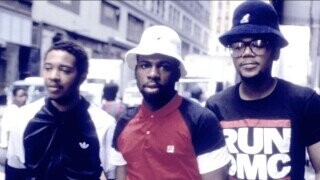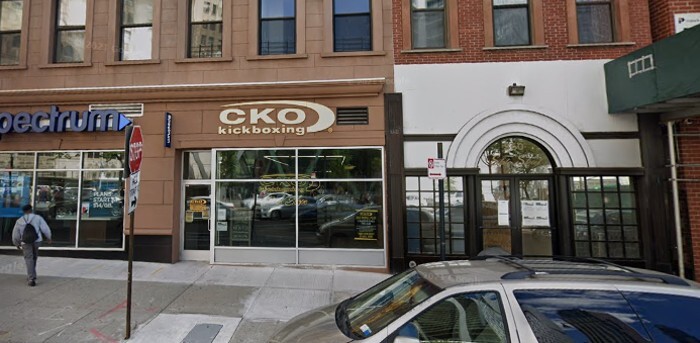Mapping Hip Hop: 15 NYC Spots Where the Movement Was Shaped

Hip hop is one of the few truly American art forms, and just about the only one white people haven’t successfully stolen. You probably know it was born in New York City, but charting its path from a house party way up in the Bronx before it did the worm through every other burrough includes some interesting stops full of even more interesting stories.
1520 Sedgwick Avenue

If hip-hop can be said to have a moment of birth, its womb was this apartment building in the Bronx, where DJ Kool Herc threw a back-to-school party for his sister in 1973 and debuted a technique he’d been working on for extending the drum break in a song by spinning two records simultaneously and his friend, Coke La Rock, started shouting out friends over the mic, inadvertently becoming the first rapper.
Cedar Park

Kool Herc’s party eventually got too big for the apartment, so they moved it down the street to Cedar Park, where he began spinning regularly. Grandmaster Flash decided to become a DJ after seeing Kool Herc at Cedar Park, and after the 1977 blackout (i.e., access to a lot of expensive, stolen electronics), DJs were spinning in parks all over the Bronx, siphoning electricity from the street lights.
Harlem World
The Harlem World club was the site of what’s considered the first modern rap battle, between Kool Moe Dee and Busy Bee in 1981. It closed in 1985, but the building still stands at the coolest address, 121 Malcolm X Boulevard.
Bronx River Houses and Neighborhood Community Center

In the ‘70s, the Bronx River Houses project was a hotbed of violence and gang activity, so resident Afrika Bombaataa founded an organization, the Zulu Nation, and started recruiting area gang members to bring everyone together in a way that didn’t involve anyone shooting at each other. The group threw parties at the community center, where hip-hop music and dancing flourished.
Lincoln Center

The Lincoln Center for the Performing Arts is home to all kinds of music history, but in 1981, it introduced the world to breakdancing by featuring two of the city’s best crews, Rock Steady and Dynamic Rockers, at its 1981 Out-of-Doors Festival. The event was covered worldwide by reporters who had no idea what they were looking at and described it with the bewildered detachment of an anthropologist’s notes: “Their dance consists of a virtuoso series of acrobatic spins culminating in a ‘freeze,’ one of the signature poses invented by each dancer,” reads one New York Times report.
The 149th Street Writers Bench
In the ‘70s and ‘80s, graffiti was more than just a slick backdrop for music videos. Bombaataa defined it as one of the four pillars of hip hop (the others being rapping, DJing, and breakdancing). Back then, artists gathered at the 149th Street Grand Concourse subway station to watch the trains go by, appraise the art scrawled over them, and “if you saw something real exciting, you’d chase the train to see who it was,” said one artist who taught an entire college class on the subject.
Hollis, Queens

In the mid ‘80s, the tiny middle-class neighborhood of Hollis, Queens became the center of the hip-hop community, largely thanks to Russell Simmons, founder of Def Jam Records, and his brother, Joseph, A.K.A. Reverend Run. LL Cool J, Ja Rule, and Young MC, among many others, all came out of Hollis. We hear it’s particularly nice around Christmas.
Weinstein Hall
Def Jam was originally run out of co-founder Rick Rubins’s NYU dorm room, number 712, where he threw wild parties with records strewn everywhere. Their first official release was an LL Cool J single, which Adam Horovitz of the Beastie Boys grabbed randomly out of a pile in Rubins’s room and later told him he had to check out.
Bad Boy Records

In 1992, Sean “Puffy” Combs discovered and signed the Notorious B.I.G. to Uptown Records, where he was A&R director, but the next year, the label decided Biggie’s album was too, uh, heavy to release and Combs’s boss did him the favor of firing him, telling him to “go and create his own opportunity.” The result was the label synonymous with ‘90s East Coast hip hop.
Tunnel

You might be surprised to find out that Tunnel, the “club kid” hub owned by the guy played by an eyepatched Dylan McDermott in Party Monster, had anything to do with hip hop history, but promoter Jessica Rosenblum began holding Sunday rap nights called Mecca there in 1993 to showcase her client, Funkmaster Flex. Soon, Tunnel was the place to be on Sunday nights for rap fans, attracting performers like DMX, Juvenile, and Jadakiss.
Columbia University

From 1990 to 1998, Adrian “Stretch” Bartos and Robert Garcia hosted the Stretch Armstrong and Bobbito Show on Columbia University’s radio station, playing songs and broadcasting appearances by some of the most famous names in hip hop when they were still unknown and often unsigned. They estimate that records sold by acts they launched (including Nas, Notorious B.I.G., Wu-Tang Clan, Big Pun, Jay Z, Eminem, and the Fugees) number around 300 million.
Quad Studios
Plenty of big names have recorded at Quad Studios, but its most important role in hip hop history arguably had nothing to do with music. It was where Tupac Shakur was shot and robbed in 1994, kicking off the East Coast–West Coast rap feud of the mid ‘90s based on Shakur’s suspicion of his northern frenemies’ involvement.
Morissana Armory
The neighborhood of Morissana in the Bronx claims a number of hip hop pioneers, including Grandmaster Flash, Fat Joe, and Big Pun, but its most Hollywood moment was the discovery of KRS-One at this homeless shelter, where he’d been living after leaving home at age 16 to pursue hip hop, by Scott La Rock, a social worker who also happened to dabble in DJing.
Jay Z’s Stash Spot

Jay Z’s “stash spot” at 560 State Street in Brooklyn, as mentioned in “Empire State of Mind,” is an apartment building where he lived in the mid ‘90s, and honestly, it’s pretty nice. Like, way nicer than you would expect for an up-and-coming rapper. It’s got hardwood floors, giant windows, and 10-ft. ceilings, or at least it did when his unit went up for sale in 2014. Admittedly, Brooklyn has changed a bit in the interim.
Biggie’s Corner

The intersection of St. James Place and Fulton Street in Brooklyn has been unofficially recognized as Christopher Wallace Way for many years and officially for a few. It’s best known as the territory a pre-fame Biggie staked out to sell drugs, but it’s also the location where the then-17-year-old was filmed rapping in 1989 in a now-viral video. This was back when you had to go home, dig out your video camera from under a bunch of eight-tracks and parachute pants in your closet, and come back if you wanted to film something. That’s how good it is.
Top image: Jeff Pinilla/Wikimedia Commons